Human-technology relations down to earth
At the Philosophy of Human-Technology Relations conference in July 2022 (PHTR2022) I gave a presentation, on research together with Wouter Eggink.
Summary
In the context of the environmental crisis and the Anthropocene the connections between us humans and our technical culture to earth/nature must be recognized as very important. After the technological flight of modernity it is time to land again, “down to earth”, so Bruno Latour. The shared challenge of design and philosophy is to find a new balance for nature, humans and technology.
Contemporary approaches in philosophy of technology have been framing technology as a quasi-natural condition of human existence. This comes to the fore in an exemplary way in the (otherwise very interesting) work of Dutch artist-philosopher Koert van Mensvoort. Humans produce a technosphere which finally becomes natural: technology as “next nature”. Is this an advanced understanding of technical mediation and the earth, or rather a very serious forgetting of nature/earth?
Thus, the present-day call for preservation of the earth against damaging technology is paradoxically complicated by the concurrent philosophical questioning of what nature and culture are. Therefore the challenge for current approaches of technical mediation is to avert such a forgetting of nature, and remain attached, down to earth.
As a contribution to this task we reconsider the place of earth/nature in our own “Product Impact Tool” as well as in the foundational postphenomenological framework of “human-technology-world relations”. This leads us to propsals for how the diagrammes of human-technology relations can be reconsidered, so as to express that our human existence is embedded and emergent in technological culture which in turn is embedded in nature.
Our contextualization of the basic scheme of postphenomenological research into technology:
from
human-technology-world
to
((( human ) technology ) earth )
Our own Product Impact Tool model is embedded in earth as follows:

The aim is not to replace the existing models, but to contextualize them with regard to the important question of how humans and technology relate to the earth.
See the presentation slides